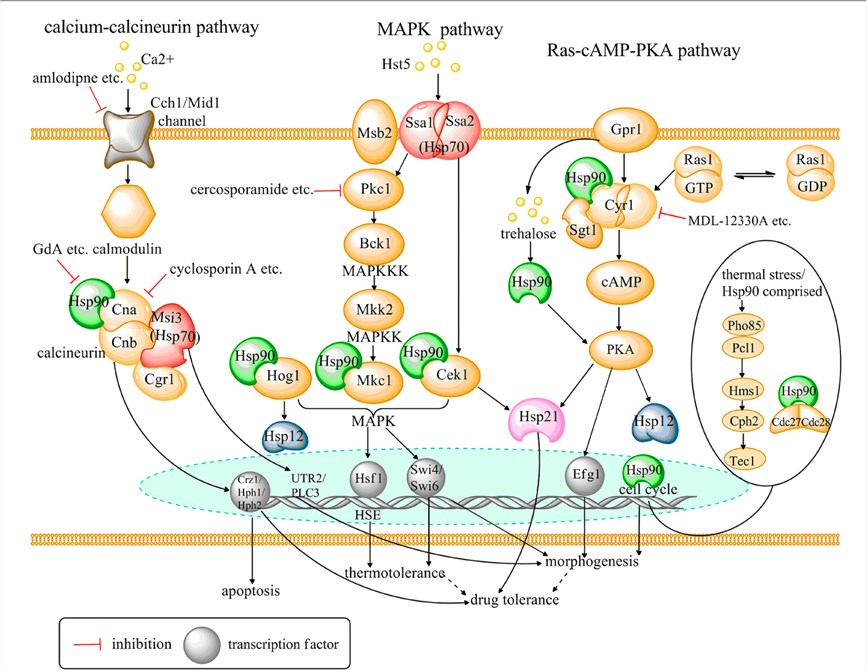Fungal infection is an important cause of morbidity and mortality, especially in patients with impaired immune function. The number of treatment options for invasive fungal infections is very limited compared to treatment options available for bacterial infections. Over the past 30 years, the importance of antifungal drugs to modern medical practice has increased dramatically. With years of experience in the drug discovery, Creative Biolabs is confident in proving high-quality antifungal drug discovery services against the heat shock protein 90-calcineurin pathway.
HSP90-Calcineurin Pathway
Heat shock protein 90 (Hsp90) is a highly conserved molecular chaperone that plays a key role in the activity of its client protein calcineurin maturation, including kinases and transcription factors, as well as signal transduction, protein folding and degradation, and morphological evolution. Hsp90 has been implicated for the thermal regulation of morphogenesis, a key virulence factor in C. albicans.
Calcineurin has a major role in calcium signaling in eukaryotic systems. In yeasts, calcineurin signaling contributes to antifungal drug tolerance. Furthermore, Calcineurin is stabilized by Hsp90 and becomes activated following its dissociation from the chaperone. In addition, Hsp90 inhibitors are mediated by down-regulation cell integrity signaling, as well as through inhibition of calcineurin signaling in a dose-dependent manner. Studies have shown that targeting the Hsp90-calcineurin pathway may represent a promising class of novel antifungal drugs to improve the persistence of IFI due to emerging MDR fungal pathogens. However, Hsp90 and calcineurin are highly conserved in eukaryotes, it is difficult to achieve fungal-specific inhibition of these targets.
 Fig.1 Hsp-associated signaling pathways and potential antifungal targets based on these pathways. (Gong, 2010)
Fig.1 Hsp-associated signaling pathways and potential antifungal targets based on these pathways. (Gong, 2010)
It is clear that the regulation of intracellular HSP90-calcineurin signaling is critical for bacterial pathogenicity (virulence factors). Further detailed molecular exploration of the HSP90-Calcineurin signaling pathway is needed to decipher more fungal-specific components with lower host immunosuppressive reactivity. We believe that the ongoing potential targets development of HSP90-calcineurin can provide a theoretical basis for the development of new antifungal drugs.
One-stop Target Discovery Services in Creative Biolabs
To meet the challenging requirements, Creative Biolabs has developed integrative approaches for new targets discovery that combines the latest advances in systems biology with structure-based techniques. Our combined approaches allow our clients to obtain the most promising hit compounds for next antifungal-based drug development. Currently, we have developed one-stop antifungal drug discovery services including:
-
Target Identification and Validation: including whole genome sequencing (WGS), computer-aided target identification and validation, structure determination, functional analysis and in vivo target validation.
-
Hit Identification: including antifungal compound libraries, virtual screening, fragment-based screening, phenotypic screening, high throughput screening, and drug repurposing.
-
Hit to Lead: including hit characterization, developability assessment of biopharmaceutical candidates, molecular engineering and in vitro pharmacodynamics.
-
Lead Optimization: including in vitro toxicity test, in vivo PK studies, pharmacology and pharmacodynamics and studies process and scale-up.
-
IND-Enabling: including toxicity and safety evaluation, pre-formulation development, formulation development, and human dose prediction.
In addition to the potential targets discovery of the HSP90-calcineurin pathway, you might be also interested in other Virulence Factors listed below:
We are wishing to cooperate with you to develop a revolutionary approach for antifungal-based drug discovery. Let Creative Biolabs boost you with drug discovery journey! Welcome to contact us for project quotations and more detailed information.
Reference
-
Gong, Y.; et al. Candida albicans Heat Shock Proteins and Hsps-Associated Signaling Pathways as Potential Antifungal Targets. Frontiers in Cellular & Infection Microbiology. 2017, 7.
For Research Use Only.


 Fig.1 Hsp-associated signaling pathways and potential antifungal targets based on these pathways. (Gong, 2010)
Fig.1 Hsp-associated signaling pathways and potential antifungal targets based on these pathways. (Gong, 2010)


